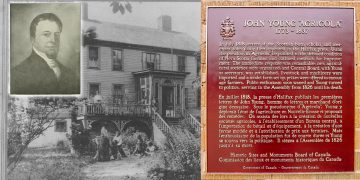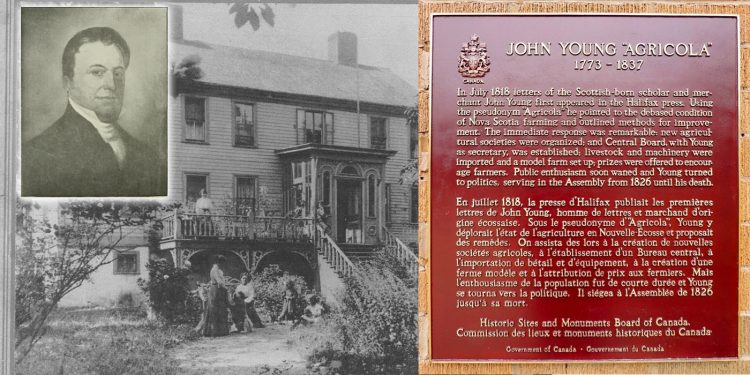By Devonna Edwards, Columnist
“Native American Traditions revere the Willow Tree as a symbol of strength and stability in old age and experience, as well as a symbol of deep inner knowledge and open-mindedness.”
Willow Park also known as Blue Bell Farm
The Willow Park House and Blue Bell Farm was once located at the corner of Almon and Windsor Streets. The name “Willow Park” has a different meaning to various generations of Haligonians and can be quite confusing to some. My earlier knowledge of Willow Park only extended to the Willow Park Military base on Windsor Street, but in earlier years there was another Willow Park located on the corner of Almon and Windsor Streets.
John Young, a Scottish man born in 1773, immigrated to Halifax in 1814 with his wife and four children and began a dry goods business called John Young and Company. He wrote letters to the Acadian Recorder newspaper in 1818 under the pen name “Agricola”, suggesting ways to help with agricultural improvement and advising the farmers to form an Agricultural Society. He purchased property in 1820 from the family of Philip Folmar, who had died that year. It was known as the Blue Bell farm site which extended to Agricola Street. There Young built a beautiful estate on the corner of southwest Windsor Street and Almon Street and called it Willow Park, due to the many beautiful Willow Trees surrounding the area. There he established his own farm, the first government model agricultural school and experimental farm, and practiced farming according to his advanced ideas. He died at Willow Park in 1837 and two years later his property was up for sale and at that time it consisted of 80 acres with 70 acres under cultivation. Young was a pioneer of scientific farming in Nova Scotia and secretary of the first Agricultural Society.
Agricola and Young Streets are named after Him
John Young “Agricola” also has a plaque honouring him on the outside of the Canada Post building located on Almon Street, on the site where his house once stood. Young Avenue located in the South End of Halifax, is named after his son Sir William Young.
After John Young’s death, John King (born in Ireland in 1799 and died in Halifax 1881) bought the house and lived there from 1838-1870, at which time Col. B.H. Hornsby purchased the property. Hon J.S.D. Thompson, Premiere of Nova Scotia in 1882, owned the Willow Park house from 1872-1894, then William Bent Freeman purchased it and was still living there in 1902.
Willow Park Subdivision
The farmland was bought up by developers and a subdivision called “Willow Park Subdivision” was planned in the 1870s along Windsor Street. The subdivision consisted of lands between Windsor and Oxford Streets, and Young and Vienna Street. At that time the land was owned by Col. Bennett Henderson Hornsby, who came from Kentucky to Halifax for purpose of land speculation, but by 1878 only ten houses were built. This area of town didn’t become widely known until the 1880s and 1890s. Almon Street formerly called Paris Street had originally been part of the “European Cities” section of Willow Park Subdivision, which also included London Street, Edinburgh Street, Berlin Street and more.
Willow Park Military Base
The park is located on the Corner of Young and Windsor Street Today Willow Park is home to the Canadian Forces Base (C.F.B. Halifax), and it stands on farm land originally owned by Philip Bayer. Bayer purchased the property, consisting of ninety-six acres, on the west side of Winsor Street, from Colonel Frederick Hamilton in 1764. It was called “The Willow” and the Bayer family had a small house on their property called “Willow Cottage”. Col. Bennet H. Hornsby and William Deal established an omnibus line in the 1870s at Willow Park at the corner of Young and Windsor Streets. The property belonged to the Transportation Department at one time and used by the city’s trolleybuses. The railway now known as the Canadian National Railway, opened freight yards and shops there and called it the Willow Park Roundhouse. A map from the Nova Scotia Archives shows the Willow Park Turntable and Roundhouse still there in 1939.
In 1940 during the Second World War, the Department of National Defence bought the property at the site of the railway shops, for an engineering yard to service its wartime fleet of motor vehicles, and it still operates as a transport and supply facility. In 2019 a new Armoury opened at the Willow Park C.F.B. site.
Windsor Park
The Canadian Forces Base (C.F.B. Halifax) located on the corner of Windsor Street and Bayers Road, opened in 1944 across the street from Willow Park. Windsor Park contains the Military Police Unit, Health Promotion Services (PSP), Integrated Personnel Service Centre (IPSC), the Military Family Resource Centre, CFB Halifax Curling Club, three intelligence companies and the Canex.
In 1955 the Department of National Defence built new modern barracks at Windsor Park, which housed Canadian forces personnel and their dependents and is still there today.
Photo credits to:
By Unknown author – Annals, North British Society, Public Domain, https://commons.wikimedia.org/w/index.php?curid=50579833
https://www.waymarking.com/gallery/
























